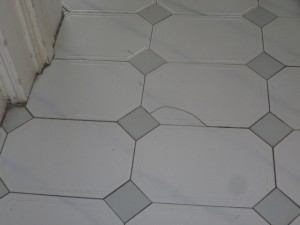Structural Survey on Pyrite Damage.
The damage that pyrite back-fill can cause is an expensive defect to remedy and stressful to the property owner. Pyrite damage in most cases can be more costly to repair then settlement or cracking in walls so it is important that pyrite damage is not incorrectly diagnosed during the initial structural survey. The percentage or concentration of pyrite in the back-fill and the depth of the pyrite under the concrete slab will determine the amount of expansion that will take place under the concrete floors. It can take up to ten years for the first signs of pyrite damage to show. Studies have shown that pyrite in back-fill can take upwards of 30-40 years to swell so that no more expansion can be expected and back-fill will become stable.

Removing the contaminated pyrite back-fill is an expensive operation and in most cases will involve supporting the existing first floor, roof structure, removing the ground floor concrete floor, partition walls, replacement and removal of all plumbing fixtures, heating and electrical systems in the affected area, before the contaminated pyrite back-fill can be removed.
Cracked Walls and Floors
Because of the wide spread use of contaminated backfill, properties that have no pyrite in their backfill or still been suspected of having a potential pyrite problem, as settlement and drying cracks are very common in houses and in some cases these cracks are been incorrectly diagnosed in structural survey reports as being a pyrite issue. The effects of pyrite expansion can, as we know take up to forty years to stabilise so it is critical that all properties particularly located in Dublin, Meath, Louth, Kildare, Wicklow, Westmeath and Offaly that appear to have swelling or cracks in their walls and floors are correctly diagnosed.
